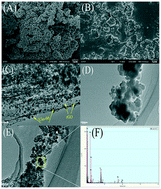Charge transmission channel construction between a MOF and rGO by means of Co–Mo–S modification
Abstract
Efficient hydrogen evolution was achieved by means of charge transmission channel construction between a MOF and rGO with Co–Mo–S modification. The maximum H2-evolution reached about 339 μmol over the rGO/MOF/Co–Mo–S photocatalyst under visible light irradiation in 5 hours, which was about 226 times higher than that of the pure rGO/MOF photocatalyst. Based on this strategy, we have prepared a rGO/MOF/Co–Mo–S photocatalyst by a facile two-step photocatalytic reduction approach, namely, GO/MOF is reduced to rGO/MOF and then the Co–Mo–S structure is reduced on the rGO/MOF surface. The Co–Mo–S acted as a charge transmission channel on the surface of rGO/MOF, providing more active sites and altering the charge transmission route. A series of characterizations, including SEM, TEM, XPS, XRD, BET, UV-vis, DRS, FTIR, photocurrent measurement, transient fluorescence spectroscopy, etc., were conducted, the results of which were in good agreement with each other. The excited-electron recombination process was greatly modulated with the introduction of the Co–Mo–S structure on the surface of the rGO/MOF photocatalyst. Furthermore, a possible reaction mechanism over the eosin Y-sensitized rGO/MOF/Co–Mo–S composite photocatalyst under visible light irradiation was proposed.



 Please wait while we load your content...
Please wait while we load your content...